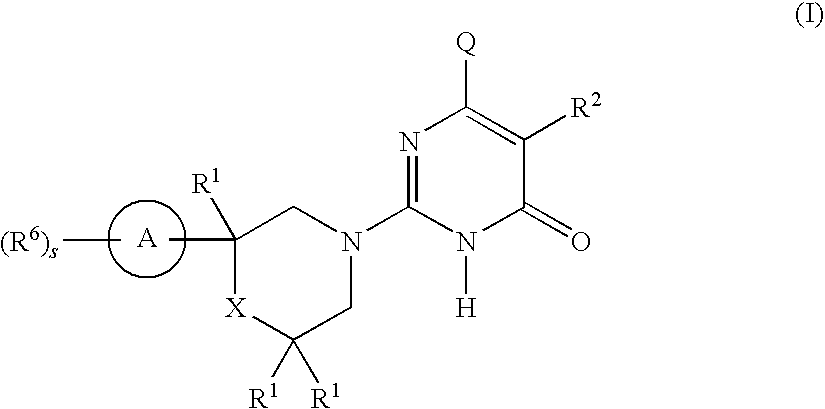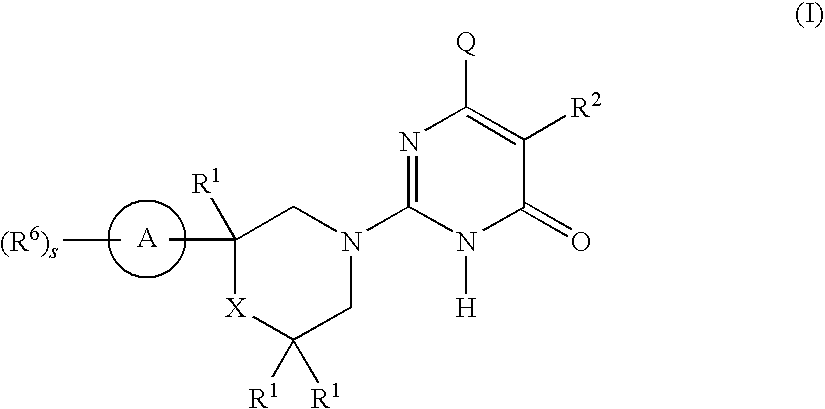2-substituted-6-heterocyclic pyrimidone derivatives as tau protein kinase 1 inhibitors
a technology of tau protein and derivatives, applied in the field of compounds, can solve problems such as neurotrophic activity, and achieve the effect of improving neutrophil and megakaryocyte recovery
- Summary
- Abstract
- Description
- Claims
- Application Information
AI Technical Summary
Benefits of technology
Problems solved by technology
Method used
Image
Examples
example 1
2-[(2S)-2-(4-Fluorophenyl)morpholin-4-yl]-1H-[4,4′]bipyrimidinyl-6-one (Compound No. 2)
[0074]
[0075]A solution of (2S)-2-(4-fluorophenyl)morpholine hydrochloride (intermediate 1, 2.1 g, 9.6 mmol), 1H-pyrazole-1-carboxamidine hydrochloride (2.8 g, 19.2 mmol), and diisopropylethylamine (6.5 g, 50.2 mmol) in methanol (25 ml) was stirred at room temperature for 12 hours. The solvent was evaporated off under reduced pressure and the crude (2S)-2-(4-fluorophenyl)morpholin-4-carboxamidine was afforded (7.47 g) as yellow oil. A solution of the carboxamidine (2.6 g), 3-oxo-3-pyrimidin-4-yl-propionic acid ethyl ester (0.98 g, 5.06 mmol), and potassium carbonate (1.4 g, 10.1 mmol) in ethanol (29 ml) was stirred at 80° C. for 18 hours. The solvent was removed under reduced pressure and the residue was partitioned between water and dichloromethane. The organic layer was dried over sodium sulfate and the solvent was removed under reduced pressure. The residue was purified by silica gel column chro...
example 2
2-{(2S)-2-[4-(5-Methyl-[1,2,4]oxadiazol-3-yl)-phenyl]-morpholin-4-yl}-1H-[4,4′]bipyrimidinyl-6-one (Compound No. 6)
[0076]
example 2-1
2-Bromo-(1S)-1-(4-bromophenyl)ethanol (intermediate 3)
[0077](S)-CBS (25 ml, (S)-2-methyl-CBS-oxazaborolidine, manufactured by Aldrich, 1.0 M solution in toluene) was cooled to 0° C., and borane-tetrahydrofuran complex (185 ml, 185 mmol, 1.0 M solution in tetrahydrofuran) was added. After the flask was cooled by ice-sodium chloride bath, a solution of 4-bromophenacyl bromide (intermediate 2, 50. 28 g, 181 mmol) in dichloromethane (300 ml) was added dropwise over one hour while maintaining the temperature at −5° C. to 0° C. After stirring the mixture at 0° C. for 50 minutes, methanol (12 ml) was added by small portions. Then, 0.5 M hydrochloric acid (300 ml) was added dropwise and the mixture was stirred at room temperature for 40 minutes. The precipitate was filtered off and the filtrate was partitioned between dichloromethane and water. The organic layer was separated and the aqueous layer was extracted with methylene chloride. The organic layers were combined, washed twice with 0.5...
PUM
| Property | Measurement | Unit |
|---|---|---|
| optically active | aaaaa | aaaaa |
| bone mass | aaaaa | aaaaa |
Abstract
Description
Claims
Application Information
 Login to View More
Login to View More - R&D
- Intellectual Property
- Life Sciences
- Materials
- Tech Scout
- Unparalleled Data Quality
- Higher Quality Content
- 60% Fewer Hallucinations
Browse by: Latest US Patents, China's latest patents, Technical Efficacy Thesaurus, Application Domain, Technology Topic, Popular Technical Reports.
© 2025 PatSnap. All rights reserved.Legal|Privacy policy|Modern Slavery Act Transparency Statement|Sitemap|About US| Contact US: help@patsnap.com



